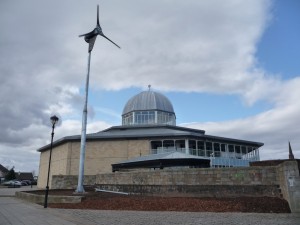Wind Turbines
Wind turbines are an excellent way to extract energy from nature, particularly in the UK. We can install a range of turbines anywhere with a good clean supply of wind, for whatever application you require, whether it be a grid connected or a battery system. The Feed in Tariff is also available on Wind Turbine installations.
The Feed in Tariff is also available on Wind Turbine installations.
See Kingspan Wind (formerly Proven Energy) for more info about the wind turbines we install. We also continue to maintain our fleet of Proven Energy wind turbines for our many happy customers.
We carry out maintenance as required on our customer’s wind turbine, as well as reactive maintenance in the case of any problems developing between scheduled services.
As well as our customers’ machines, we can also service sites installed by other installers if required, which we do for the same rates, as per below, subject to inspection and approval of the installation.
Service Rates
Proven 2.5/Kingspan KW3 – £275 + Travel at 50ppm and VAT
Proven 6/Kingspan KW6 – £375 + Travel at 50ppm and VAT
Proven 15/P35-2 – £475 + Travel at 50ppm and VAT.
All parts over and above the usual sundries are charged at cost + 20%, plus any additional labour. Additional visitr required to repair problems will be quoted for prior to you committing to proceed.
What is wind power?
Wind turbine The power of the wind has been harnessed for thousands of years for milling grain and pumping water. Today it is the second biggest source of renewable energy after hydroelectricity.
The power available in the wind is harnessed through the use of large aerofoil blades that rotate under the force of a moving air mass. This converts the kinetic energy of the wind into the mechanical power of a rotating turbine shaft, which is then used to generate electricity.
Power from the wind varies with the cube of the wind speed. This means that doubling the wind speed results in eight times as much power. Relatively minor variations in wind speed can therefore result in large changes in potential output and proper siting of the turbine is very important.
A wind turbine essentially consists of a set of tower-mounted blades that are connected to an electrical generator. Wind speed increases with height above ground level, so higher turbines are usually able to generate more power.
The vast majority of wind turbines installed today are horizontal axis. This means that the blades rotate around an axis perpendicular to the turbine tower. In order to ensure as much power is captured as possible, many turbines have a yawing mechanism that allows them to continue facing into the wind when it changes direction.
The electricity produced by a wind turbine is alternating current (AC), but a rectifier and inverter are usually required to stabilise the voltage and frequency of the output before it can be connected to any electrical loads. If the building
supplied by the turbine has mains electricity, any excess electricity can be exported to the national grid.
Alternatively, when demand is high, extra electricity can be purchased from the national grid through the utility companies.
How fast does the wind have to blow?
Most wind turbines will generate electricity only when the wind speed falls within a certain range. The minimum “cut-in” speed of the Proven turbines we install is 2.5 m/s. Below this speed, your turbine will not produce any electricity.
Unlike many wind turbines, Proven turbines have been designed to safely withstand high wind speeds whilst continuing to generate, and therefore have no maximum “cut-out” speed.
As the wind speed increases, the blades twist to reduce their aerodynamic efficiency. This allows it to keep running in even the fiercest of storms. Proven turbines reach their maximum output at 12m/s. Wind speeds above this will not result in any further increase in electrical output.
What do I need in order for a wind turbine to work?
In order for your site or property to be suitable for a wind turbine, you will need an open area of land exposed to the prevailing wind. Because the wind turbine is so sensitive to changes in wind speed, it is essential that it be kept as far away as possible from any obstructions and sources of air turbulence, including trees and buildings.
The performance of the turbine will also depend greatly on the wind resource in your area. A good average wind speed is required throughout the year, typically above 5 m/s.
The DTI UK Wind Speed Database can provide an estimate of annual mean wind speeds throughout the UK. This acts as a guide for assessing wind speeds in your general location, but local topography and obstructions can lead to actual average wind speeds being different from those predicted.
What is the lifetime of a wind turbine?
A wind turbine will last approximately 20-25 years or more if properly serviced and maintained. Servicing should take place annually in order to check all mechanical and electrical parts.
01292 591 000
Or Request assistance:



